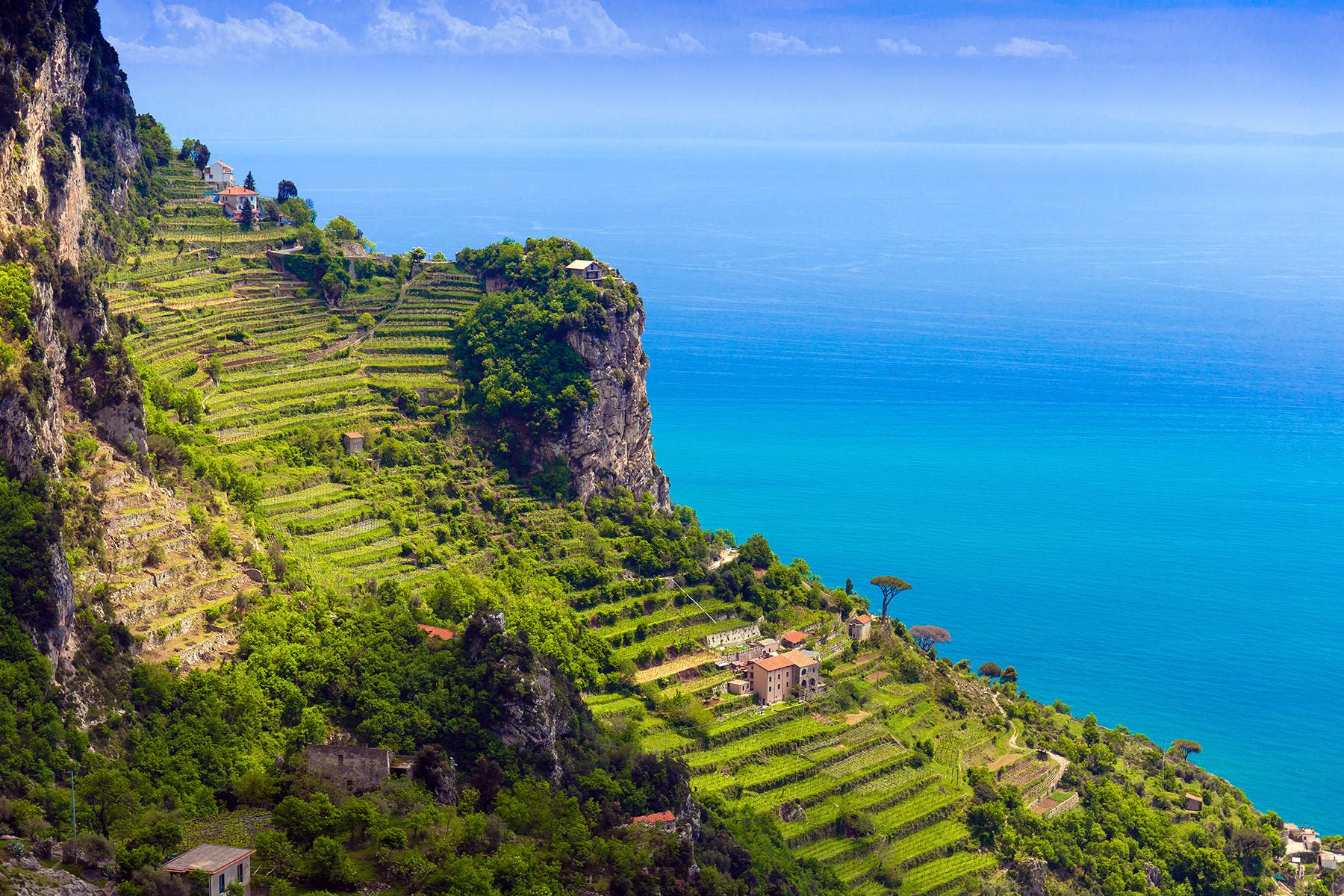The most satisfying way to explore the twin bays of Naples and Salerno is on foot.
Campania provides spectacular topography for walking, combining dramatic coastlines and mountains with captivating cityscapes. Modern life hurtles along atop medieval and ancient layers in Napoli. The Bay of Naples sits on a tectonic fault that bubbles with volcanism; there’s also a limestone spur of the Apennines that has buckled to form the dazzling Amalfi Coast and Capri.
West of Naples and to just to the east around Vesuvius, you can walk amid active and dormant volcanoes. The archaeological sites Pompeii and Herculaneum provide a chance to follow in the footsteps of Roman citizens. Vesuvius lies within a national park that is worth seeking out as it’s not often you can feel the steaming heat warming your soles. Rare orchids, lichens, and lizard species thrive in adversity here. Towards Sorrento, Amalfi, and Capri, shepherds and trekkers share the limestone coastline along mule tracks and terraced olive groves.
Path of the Gods
WHERE: Amalfi Coast, Naples
High up the limestone cliffs of the Amalfi Coast, centuries-old trails and mule tracks provide some of the most spectacular hiking in Europe. The classic Sentiero degli Dei route links the hilltop towns of Agerola to Nocelle and is best tackled westwards for the most awesome views. Reaching the mountain pass Colle Serra (1900 feet), walkers can picnic in the wildflower-filled terraces grazed by sheep and goats and walk past chestnut and oak trees and macchia mediterranea scrub. Adventurous types should seek out the Vallone di Grarelle with its pinnacles and caves.
INSIDER TIPPack a picnic before ascending. Alongside some pomodori and panini in the villages, you can pick up the freshest Agerola cheeses, such as fior di latte (cow’s milk mozzarella) and Provolone di Monaco.
Lungomare di Napoli
WHERE: Naples, Italy
For the ultimate gelato-slurping Neapolitan family passeggiata head to this scenic waterfront promenade in Naples, lined with restaurants and many an ornate statue and attractionIts present form took shape after a cholera outbreak in 1884, when the nascent Italian state enacted Il Risanamento (urban renewal), sweeping away old fishing communities and slums and reclaiming land from the sea. Up until 2012, this sweep of coastline was spoiled by roaring traffic, then Mayor Luigi de Magistris created the lungomare liberato (a waterfront freed of traffic).
INSIDER TIPFor an alternative and leisurely view of the lungomare, hire a bike and cycle the entire stretch. Some pizzerie even have them available to patrons so you can burn some calories after your margherita and birra.
Recommended Fodor’s Video
Vesuvius National Park
WHERE: Ercolano, Vesuvius
As well as the short walk up to the crater rim of Vesuvius from the official car park, there are 11 trails within the Parco Nazionale di Vesuvio. Those after an epic trek should opt for Trail 4 through the Tirone Alto Forestry Nature Reserve established in 1974. On this seven-mile, six-hour hike, you can spot rare orchids and abundant wildlife, including snakes, hares, foxes, lizards, and cuckoos. Between the trees there are views of the bay, up to the Gran Cono and towards the lava flows of 1944.
Herculaneum
WHERE: Ercolano, Italy
Most people head straight to Pompeii to dig deeper into the history of the infamous AD 79 eruption, but Herculaneum is easier to get around and has riches aplenty. So far there are just six Insulae (blocks) that have been excavated and lots to see within a manageable hoofing distance.
INSIDER TIPIf extremely hot or other extreme weather is forecast, a visit to Herculaneum is the sensible option over Pompeii.
Monte Solaro
WHERE: Capri, Italy
For the most tranquil and spellbinding hilltop atmosphere and views around the gulfs of Naples and Salerno and beyond, Monte Solarno is the must-do Caprese excursion. To save the calf and thigh muscles, take the serene chair-funicular ride from Anacapri up to the 589-meter terrace. As the single chairs dangle over the small gardens and vegetable plots, drawing away from the buzz of Anacapri, a tingle-inducing metallic sound of the machinery prefigures the ethereal experience above. There’s a café at the top and you can wander amid the macchia mediterranea scrub to gain different vantage points. Then you can either bound back down the path to Anacapri, take another dusty trail to the Cetrella church, or take the easy chair-lift descent.
Monte Epomeo
WHERE: Ischia, Italy
Ischia’s 2600-foot-high mountain is an extinct volcano with some otherworldly sculpted rock formations pitted with volcanic bubbles. The effort of taking the 45-minute walk from the charming piazza and church at Serrara, through Fontana and dusty woods, can be justly rewarded with a visit to the terrace restaurant La Grotta del Fiore on the summit. There’s an unusual 15th–century church and hermitage Chiesa di San Nicola here worth a gander too. On a clear day, there are azure vistas over the Golfo di Napoli and to the distant smoking volcano of Stromboli.
INSIDER TIPWear suitable footwear, especially in wet weather, as the smooth tufa rock is very slippery.
Paestum
WHERE: Paestum, Italy
Visitors to mainland Italy’s most important Greek ruins at Paestum have the chance to walk in the footsteps of former resident Pythagoras and thousands of Grand Tourists. Amid the extensive grounds, enlivened in primavera by butterflies and other creatures buzzing around poppies and other wildflowers, there’s ample space to escape the crowds. After wandering between the Greek temples and Roman macellum (market), find a spot to sit and munch on picnic snacks while contemplating the most captivating views.
Spaccanapoli
WHERE: Naples, Italy
Spaccanapoli (literally split-Naples) and its parallel street Via dei Tribunali are the two east-west streets that cut through the ancient center of the Greek founded city of Neapolis. Along these decumani Neapolitan daily life is played out and hung out for all to see. Just go with the intoxicating flow and leave your valuables in a hotel safe and keep an open mind to fully explore. Although these long streets start up the hill of the Spanish Quarter most visitors begin by the baroque obelisk Guglia dell’Immacolata. You can easily spend a couple of days dodging the Vespas between visiting a handful of churches, tempting bar-pasticcerie, and curious shops.
INSIDER TIPOn a hot day you can cool down and explore the layers of the city in the underground tunnels of Napoli Sotterranea on piazza San Gaetano
Capri Town to Villa Jovis
WHERE: Capri, Italy
Reaching Emperor Tiberius’ infamous and colossal palace from which he ruled the Roman Empire from AD 27-37 requires about an hour’s legwork from the Piazzetta, Capri Town. On the way you pass chic shops, flower-fringed lanes, and colonnaded gardens with many a lucertola (lizard) and gatto (cat) for company.
Valle dei Mulini
WHERE: Amalfi, Italy
Also known as the Valle delle Ferriere, the Valley of the Mills is often explored from Amalfi, as a short excursion and welcome escape from the crowds. For a more rewarding experience, there’s a 4 mile-long path crisscrossing the Canneto River and passing through terraced lemon and olive groves. The ruins of stone mill buildings that once drove paper and lime production makes for welcome and picturesque spots to take a breather.




